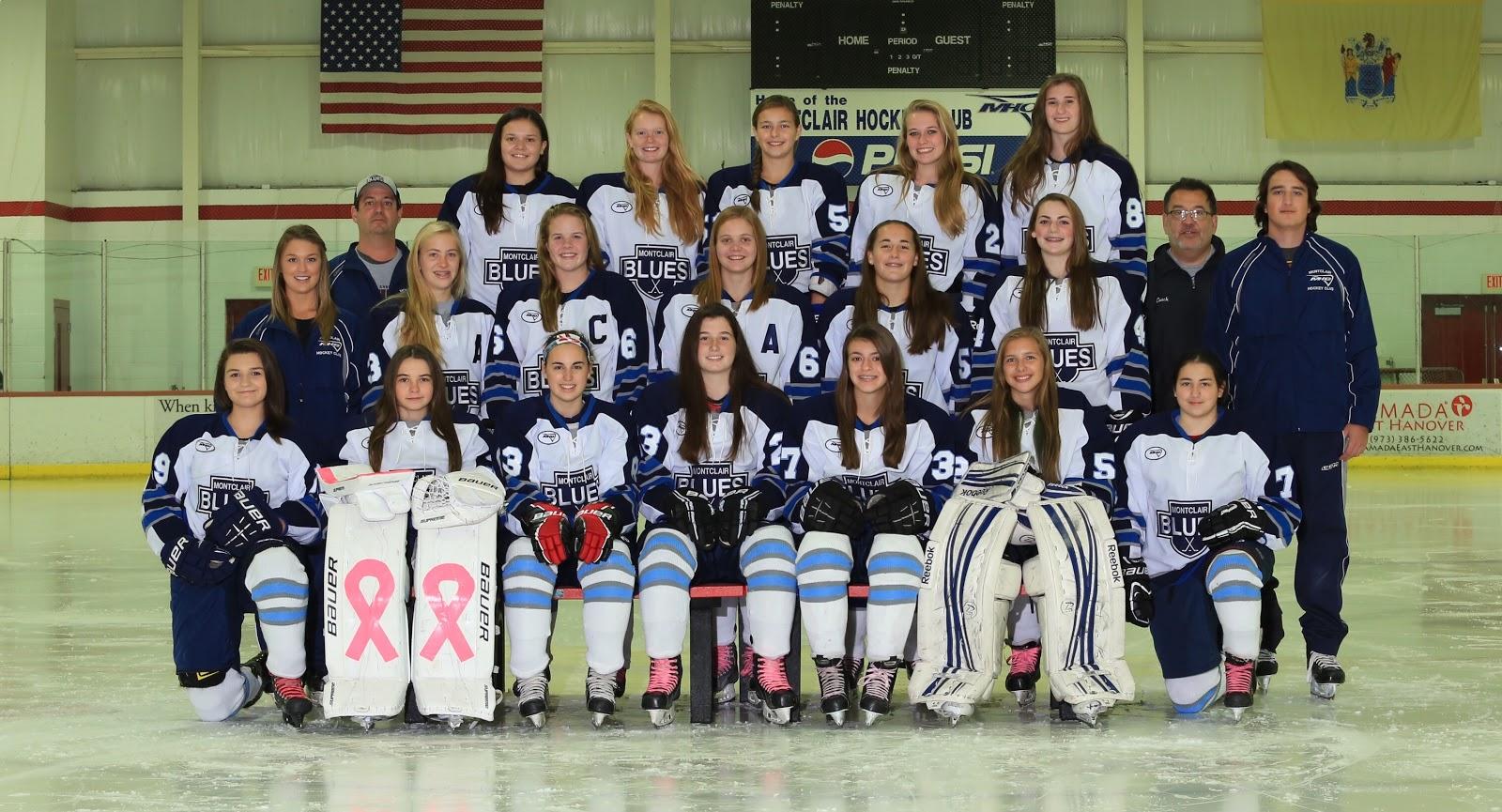A liter of sweat, a leader of ice
May 21, 2015
The rink fell silent. Only the sounds of the puck dropping to the ice and the shouts from teammates could be heard, muffled by the thick padded helmet.
Julia Gaffey, a member of the Montclair Blues Girl’s 16U ice hockey team, skated into position at the Lake George girl’s ice hockey tournament. The referee placed the black vulcanized-rubber puck on the cold, slick ice. This indicated the start of Gaffey’s first penalty shot.
Yet despite the novelty, Gaffey appeared just like the ice before the game: cool and ready. Her mouth guard securely in place, number six on her back, and sporting a capital “C” on her sleeve.
Approaching the puck with her black stick, handling it with the white of its blade, Gaffey positioned her stick, attempting to score what seemed to be a backhand goal. The goaltender was as ready as she was, though. Then, Gaffey faked the goalkeeper, along with her teammates, and switched into position for a forehand shot.
The slapping sound between the puck and the blade of the stick rang out.
I realized how much I hated ballet, so I followed in my brother’s and dad’s footsteps and tried hockey.
— Julia Gaffey
The Montclair Blues and their fan section cheered wildly as the puck hit the back of the net, with Gaffey scoring her first penalty shot goal after eleven years on the ice.
Although competing a high level intensity leads to memorable moments such as these, ice hockey was not always a competition for Gaffey.
“I may not have knew it back then but, playing that young, winning didn’t matter, so it was all fun,” Gaffey says.
Like many five year-old girls, Gaffey attended ballet classes regularly. Yet watching her brother and father play hockey, Gaffey’s interest was gradually taken in by the game when she was five years old.
“I realized how much I hated ballet, so I followed in my brother’s and dad’s footsteps and tried hockey,” Gaffey says.
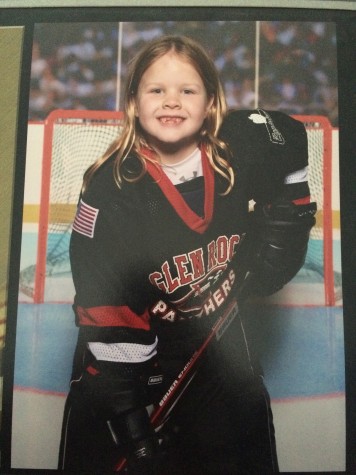
Gaffey sporting the Glen Rock Panthers jersey that she wore for three years of her ice hockey career.
Gaffey grew up with the game of hockey in her house. Her brother, Michael, and father, George, were very interested in the sport. With a hockey coach as her father and a growing love for the game, Gaffey picked up her hockey skills rather quickly. After working with her father, the fundamentals quickly fell into place.
Soon, Gaffey was eager to join a team.
The selection of teams for a young female ice hockey player was slim to none. Consequently, Gaffey played on Glen Rock all-boys teams from the ages of six to eight.
Eventually Gaffey landed on her current team, the Montclair Blues. Over the course of eleven years of learning and mastering the game, Gaffey has been a member of over three different ice hockey teams.
At the age of nine, Gaffey joined her first all-girls ice hockey team, the Montclair Quarry Cats Organization. Yet her team ran into some problems due to a lack of other girl’s ice hockey teams as opposition.
“This year the Quarry Cats Organization folded into the boy’s league, the Montclair Blues Organization,” Maureen Gaffey, Julia’s mother, says.
Lack of availability is a recurring theme for female hockey players, whether it is a lack of teams or a lack of girls exposed to the game enough to have an interest in trying out.
The Montclair Blues
Finding a team is a major problem for female hockey players in the United States. As Gaffey points out, “unfortunately there isn’t a WNHL… but girls can still go to the Olympics.”
This did not hold Gaffey back in finding club teams. She has been on the Montclair Blues team for several years now with her friend and teammate, Hope McGivney.
McGivney, who has had her own experiences with finding a team, says, “There are many more girls hockey teams now than there used to be.”
Over the past six years as a member of the Montclair Blues, they have been in competitive tournaments and spent hours practicing.
Gaffey’s position on the team is the “first line center.” This position entails a great amount of skill. Her first job is to win the faceoff, then the playing begins. Skating more than any position, the center then must focus on assisting her teammates or scoring herself. This position suits Gaffey not only in her playing, but also in her role as a teammate off the ice.
Gaffey, over the past two years, has been the captain of her 16U team. Chosen by her teammates to lead the team, her leadership and dedication were put to the test, but she did not falter.
“She’s always there for her fellow players if they have a question or a concern,” says Gaffey’s coach, Dave Solomon.
From her coach’s perspective, Gaffey handles the role of captain very well with her problem solving skills and her ability to recognize potentially detrimental situations and act accordingly.
Gaffey focuses on giving her teammates her full effort and always “gives one hundred percent. ” Considering that her teammates come from as far as forty-five miles away, the act of being both present and on task is vital to the success of her team.
“I try my best to make my teammates better,” Gaffey says.
While leadership on the ice is a major contributing factor to her team’s success , leadership off the ice is equally as important.
“She gets everyone focused and ready to go before our games,” says Gaffey’s teammate and friend, Aislinn McAleer.
Julia is a very funny person off the ice and she never fails to give everyone a good laugh.
— Aislinn McAleer
Before games, the team awaits the signal to enter the rink. Skates laced up and padding on, the players are focused on the task ahead of them. The locker room is quiet with the lights turned off, a Montclair Blues tradition. Gaffey, being captain, “says a few words to pump everyone up.”
Sitting in the pitch-black locker room, Gwen Stefani’s Hollaback Girl is blasting from the speakers. The team’s pre-game ritual is complete and they are prepared to take the ice. Hearing the support of the captain, the team is then ready to go.
Gaffey’s infectious positive attitude is just one addition to the long list of attributes that qualify her for the captain’s position. Her friendship off the ice with her fellow teammates is also proof of this.
“Julia is a very funny person off the ice and she never fails to give everyone a good laugh,” McAleer says.
McGivney adds, “Julia’s a great friend and she’s fun to be around.”
A multi-sport letterer, member of the National Honors Society, and student body recording secretary is a lot to handle on its own, but Gaffey manages to balance her ice hockey career on top of this all.
“I think I do better in school when I play sports. It gets me to manage my time and stay focused,” says Gaffey.
The discipline learned from the demanding schedule of playing ice hockey is a valuable experience that will last a lifetime.
For several years, Gaffey’s schedule consisted of volleyball practice in the fall, basketball in the winter, lacrosse in the spring, nights filled with homework, and hockey practice.
After her freshman year of high school, Gaffey dropped volleyball but kept up with basketball and lacrosse diligently. This diligence also included her time on the ice.
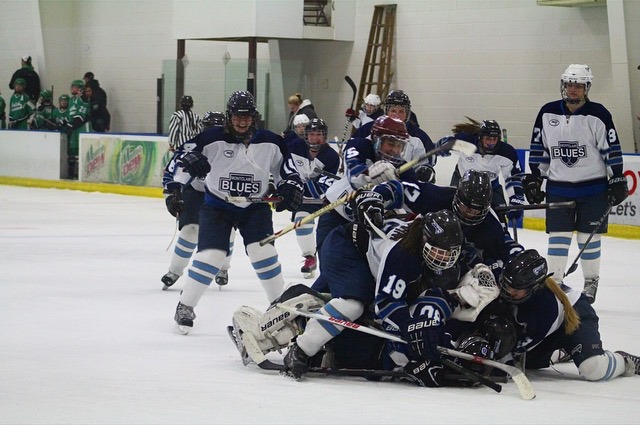
Gaffey’s team celebrating after an exciting victory.
The Road to Districts
This year, her junior year, Gaffey played for the Montclair Blues 16U team.
Gaffey’s team finished second in their league. If they follow on this positive path, nationals in Michigan could be in their future.
Julia is a very determined and focused player. Her competitiveness and desire to perform has been a tremendous asset to our team.
— Coach Dave Solomon
“Julia is a very determined and focused player. Her competitiveness and desire to perform has been a tremendous asset to our team,” Coach Solomon says.
These components in a captain are parts of the building blocks of a successful team. Gaffey is not only valuable on her own, but the influence she has had on her teammates and her commitment to them is irreplaceable.
“The sport requires commitment over a very long season,” Mrs. Gaffey says.
With the leading example Gaffey provides for her team, it is unanimous that this season was one to remember.
A group of skilled girls ice hockey players that work well together is a crucial aspect to success. Luckily, this group of athletes not only played well together, they also motivated each other.
The word “team” is sometimes used loosely, but when referring to the Gaffey’s team, it is the only word to describe the group of girls.
“They play as a team and trust and rely on each other,” says Mrs. Gaffey, who has observed and cheered on the team at many tournaments.
Gaffey’s teammates reflect on the years spent carpooling to practice and creating memories.
“We have a lot of fun and have been carpooling for the past 5 years,” McGivney says.
After coming out of leagues in second place out of six teams, the team’s momentum was pushing them forward. After leagues, the next step is districts.
“This year’s season stood out compared to past seasons because we had a strong season with a lot of wins,” McAleer says.
The Montclair Blues arrived ready to play. The opponent from the first place team in the league brought a good game. The Montclair Blues lost two out of three games, but not without a fight. The winning team was off to Michigan for nationals.
Although their road ended here, the season is one to positively reflect on.
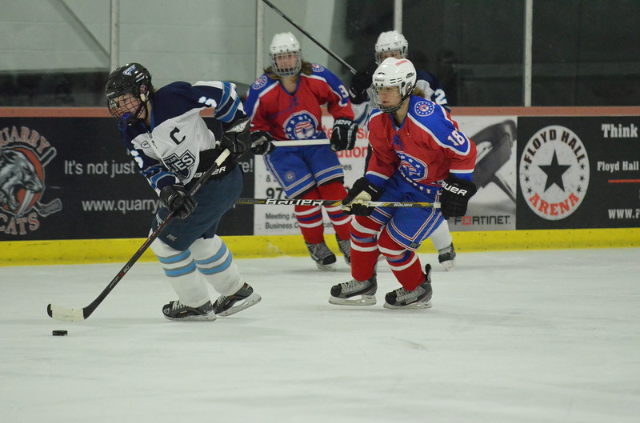
“Some of my best memories of this season was during the tournaments even though we didn’t always come out with a win we always gave it our all and had a great time together,” says McAleer.
This mentality is a major contributor to the team’s triumphs. A positive attitude makes all the difference when participating in a team sport. Not only does it create a better functioning team, but it also creates a positive experience for the players. While athletics are competitive, they should always bring joy to the athletes, something many teams lack.
“Hockey is really fun for me but also very competitive, which is a good balance,” says Gaffey.
While every tournament brought the chance to bond with teammates and make memorable plays on the ice, one tournament in particular stands out to Gaffey.
The memories transport Gaffey back to the victorious moment when the puck hit the back of the net, scoring her first penalty shot at the Lake George tournament.
After the three-hour long drive, Gaffey and her mother finally reached their destination—-Lake George, NY. The team congregated before entering the large arena.
As the team proceeded to the rink, the cold air met their skin. The rink was colder than the girls are used to playing on. Like any good athlete would, the Montclair Blues 16U team decided that they were not going to let this affect their playing.
“We played through it,” says Gaffey, which is validated by their record from Lake George.
The Montclair Blues, lead by Gaffey, outplayed the opponents. Making the trip a success, they made their way to the championships.
Fighting through the cold and the competition, the last game standing between them and first place was the toughest of the tournament. Skating up and down the freshly-groomed ice, both teams were not going to give up. The buzzer rang out signaling the end of the game. The teams looked at the scoreboard to see that the game had ended in a tie. They would have to play in overtime. Gaffey’s team finished on top, winning the tournament.
Gaffey says Lake George was the “best tournament,” adding, “We played so well.”
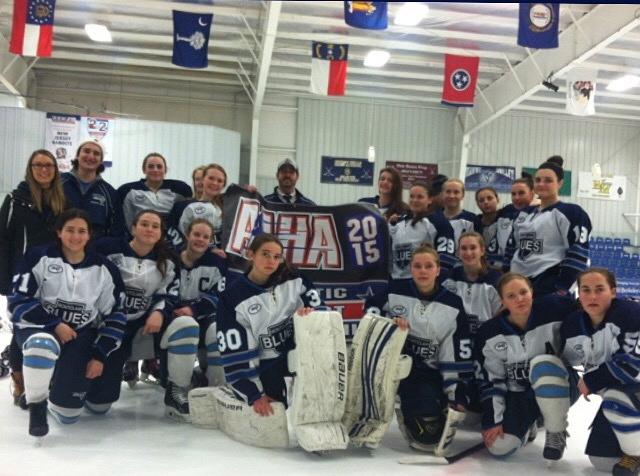
The Montclair Blues proudly posing in front of the well earned banner.
An Inspiration on the ice
To play on and lead such a successful team does not come easily. Gaffey has had many role models that helped her in her hockey career. One of Gaffey’s favorite female ice hockey players to look up to is Meghan Duggan.
Duggan, now 27 years, started out playing ice hockey very similarly to Gaffey. Observing her brother playing, Duggan gave it a try.
Flash forward to high school and, much like Gaffey, Duggan was juggling multiple sports, including lacrosse and hockey.
“I can relate to her many ways,” says Gaffey.
I could also see myself possibly coaching one day.
— Julia Gaffey
Pursuing her career in ice hockey further, Duggan went off to play Division I ice hockey at the University of Wisconsin. All the while, Duggan focused on her academics as well.
In 2010 Duggan competed on the United States of America female ice hockey team in the Winter Olympics. In 2014 Duggan competed as the captain of the US Olympic team.
Duggan has since gone on to begin coaching ice hockey, something that Gaffey sees as a possible future for herself.
“I could also see myself possibly coaching one day,” says Gaffey.
Many parallels can be drawn between Gaffey and Duggan. Duggan is a model of a female ice hockey captain that has balanced sports, leadership and academics. But, Gaffey sees a different future for herself.
For some club hockey players Gaffey’s age, the college recruiting process has already begun, but Gaffey is looking for a different direction.
“If I play at all in college it will be at the club level,” Gaffey says.
College club level athletics offer the competition and enjoyment of the sport without the intensity of playing on the varsity teams.
“I love the game, but I’d rather not spend every second playing hockey in college,” says Gaffey.
Looking Forward
While many may assume due to the lack of high school girl’s ice hockey teams, that females’ opportunities to play are less than those of male players. This is not necessarily the case.
“In retrospect, boys and girls do have the same opportunities. Girls and boys can both go “D1” or “D2” or “D3” or club or to the Olympics if they have that much talent,” says Gaffey but adds, “the big difference is that boys can go pro while girls can’t.”
The main difference is the recognition female players get in comparison to male ice hockey players. Gaffey “think[s] girls hockey should become more of a recognized sport.”
Ice hockey teaches Gaffey and her teammates valuable life lessons, such as discipline and teamwork.
“I think every girl should get the opportunity to play,” Gaffey says. “They shouldn’t be afraid to try something new.”
